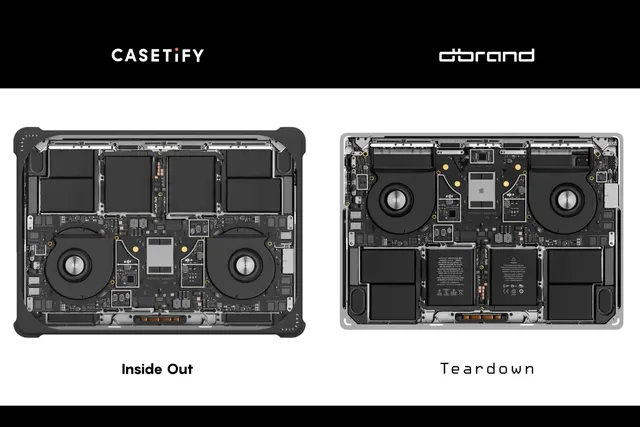Dbrand, the device skin business notorious for mocking brands such as Sony and Nintendo, is fighting its legal struggle. The firm is suing Casetify for openly stealing Dbrand’s Teardown device skins and covers, designed to look like the internals of whichever phone, tablet, or laptop you purchased. (It’s also releasing some new X-Ray skins on the same day it announces the lawsuit.)
Dbrand first introduced its Teardown items in 2019 in collaboration with JerryRigEverything (Zack Nelson), a YouTuber who disassembles new electronics and sometimes modifies them transparently.
Teardown skins and cases give the impression that you’ve disassembled your device and slapped on a transparent backing when it’s merely a vinyl decal or a case that you slip your phone into.
Even while applying a decal on the back of your phone is rather simple, a significant amount of effort goes into creating the designs. Dbrand must thoroughly disassemble the gadgets for which it wishes to create a Teardown design, whether an iPhone 15, an iPhone 14, a Google Pixel 8, a MacBook Pro, or a Galaxy Z Flip 5.
It then uses commercial-grade equipment to scan its internals and imports the image into editing tools. Before printing, it performs several changes, including eliminating screws, ribbon cables, and wires, as well as relocating some of the components around to ensure the design fits on the back of the phone, laptop, or tablet.
Casetify is said to have taken all of this work and used it on its phone cases. Casetify removed the offending case lineup from sale on its website within 24 hours of Dbrand’s complaint being made public, claiming it has “always been a bastion of originality.”
Dbrand Is Suing Casetify For Ripping Off Its Teardown Designs
It all began when Casetify released a similar line of phone cases called Within Parts, which features an image of the components within your phone on the outside. However, users observed that something was off about the designs. In March, a user on X (previously Twitter) pointed out that Casetify appeared to be repeating the same image of the same internals across numerous phone models, implying that they could have truly depicted the insides of each handset for which they were offered.
Dbrand pointed up Casetify’s apparent blunder in a video posted to X, demonstrating how Casetify appeared to have reused the identical design across Apple, Samsung, and Google smartphones, with the caption “iNsiDe PaRtS.” Dbrand has returned with a new collection of transparent-style phone covers dubbed Inside Out, just months after posting its reaction to Casetify.
This time, the graphics match the devices for which the covers are designed, and Dbrand believes this is because Casetify stole its designs. Dbrand, on the other hand, claims Casetify attempted to conceal the copycats by rearranging elements of the designs to make them appear somewhat different. (An example of this can be seen in the movie posted above.)
There’s also some substantial evidence to back up Dbrand’s claims. Dbrand discovered several Easter eggs hidden within its designs on Casetify’s Inside Out goods. This features the “R0807” tag, which refers to Dbrand’s claim as a robot-run brand, and the JerryRigEverything catchphrase “glass is glass and glass breaks.”
Dbrand Is Suing Casetify For Ripping Off Its Teardown Designs
Dbrand discovered Casetify allegedly replicated 117 different designs, down to the many digital changes it made to the photographs, after analyzing the images of the cases on Casetify’s website — and even ordering several to validate its suspicions. Dbrand claims to have registered copyrights for all of these items, which were all registered before Casetify’s product launch.
“If CASETiFY had simply created their own Teardown-esque design from scratch, we wouldn’t have had anything to take issue with,” Dbrand CEO Adam Ijaz tells The Verge. “We have no doubt that dbrand owns the concept of disassembling phones and scanning them. The truth is that they reused our previous designs for their products, then went to considerable pains to disguise their unauthorized use of our work.”
Instead of issuing a cease-and-desist order, Dbrand has filed a federal action against Casetify in Canadian courts, where the company is domiciled, demanding eight figures in damages. It also didn’t provide Casetify any notice, which resulted in the cases in question being removed from the Casetify website within 24 hours of the lawsuit being made public. An archived version is still available via the Wayback Machine.
“We are currently investigating a copyright allegation against us,” Caseify writes on X. “We have immediately removed all the designs in question from all platforms.” In addition, the corporation says it is investigating a DDOS attempt that “disrupted” its website “when the allegation surfaced.”
Dbrand Is Suing Casetify For Ripping Off Its Teardown Designs
Dbrand is also launching a new set of X-ray skins across its entire portfolio today, which differ from the Teardown ones in that they’re black and white, captured at 50-micron resolution by a lab called Haven Metrology, and show details that would not be visible simply by removing the back cover of a phone, laptop, or gaming handheld.
While Ijaz says he doesn’t want anyone to think the lawsuit is a money grab, the release of the new skins doesn’t appear to be a coincidence; JerryRigEverything’s video about the lawsuit prominently features the new X-Ray skins, and Nelson suggests twice that fans buy one to support legal efforts against Casetify.
SOURCE – (AP)







:format(webp)/cdn.vox-cdn.com/uploads/chorus_asset/file/25089463/dbrand_casetify_easter_egg.png)




